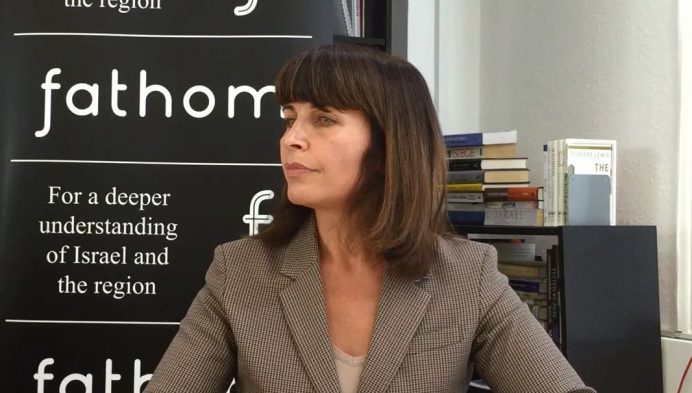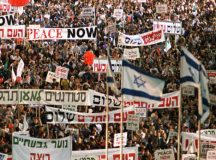Einat Wilf is one of the most creative Israeli thinkers on the peace process. In this talk to a Fathom Forum in London on 15 June 2017 she argued that it is time to drop the dogma that ‘constructive ambiguity’ helps advance the peace process. In its place, Israelis and Palestinians need to adopt a new strategy of ‘constructive specificity’ regarding what is required from each side if the process is to result in a realistic peace. Below is an edited transcript.
What I am going to be discussing today is based on part of a paper that I wrote for the Washington Institute that looks in detail at the strategies that are needed by foreign policy decision-makers in the West if they are truly interested in ensuring that the path to a the two-state solution is kept open.
From ambiguity to specificity
I am going to reflect on something central to the thinking of many policy-makers working to achieve peace. It is the notion that given the animosity, the distrust and the competing understandings of history, the way to make peace is through ‘constructive ambiguity’. Shimon Peres, with whom I had a chance to work for a few years, used to say that ‘in love-making, as in with peace-making, you need to close your eyes’. I’m not going to discuss people’s preferences in the bedroom, but with respect to peace-making, I think that this perspective is not very helpful. The idea that we can close our eyes a little bit, that we can fudge the issues, that we can use words knowing that we understand those words one way and that the other side understands those same words in a completely different way – I think by now we have enough experience to know that this method is anything but constructive.
We now have two decades of experience with constructive ambiguity and it’s clear that we should really call it destructive ambiguity. If we are to move forward what we need is constructive specificity. We need to be very clear about what we mean on the key components, on what makes peace possible and what it means to divide the land between the Jordan River and Mediterranean sea into (to use the words of the UN) ‘a Jewish state and an Arab state’. If we are to finally complete the partition, I believe that what is needed is for us to be very specific.
Constructive specificity about the border
What does constructive specificity mean? The first issue is the line of partition. Here we have a lot of words that are being used, such as ‘the 1967 lines’, ‘pre-1967 lines’, and in Israel talk of ‘settlement blocs’ and ‘the barrier’. These kinds of words are, in the context of an agreement, used to describe where the border would be. But the time has come to be very specific about what we mean about the line of partition. When we say something like ‘the 1967 lines with swaps’, it is a good headline but it encourages both sides to continue to be unclear about where that line is. Everyone knows where the pre-1967 lines are, but once we introduce the idea of blocs and swaps it gets muddied.
The one thing that needs to happen, both in Israel and abroad – and this is something I am campaigning for, writing about and proposing that politicians take it as their agenda – is to actually put on the table a very clear delineation of Israel’s final eastern border. I have published articles which list the settlements that Israel needs to include within its final eastern border and the ones it needs to exclude. The foreign ministries of Western countries interested in the conflict should do the same thing. Put a map on the table and begin to base a policy on this map. Say ‘this is our working map of what we find acceptable’. We know what has undermined both American and EU foreign policy in the eyes of Israelis is that by failing to make a distinction between settlements that will be part of the state of Israel in a future agreement and those which will likely not be, the US and EU have not helped anyone’s ability to fully understand what is needed to reach a final agreement.
I propose that the main blocs, except Ariel, should be part of Israel. Ariel goes too deep into the West Bank to be included. I propose that Ma’ale Adumim and Givat Zeev be connected to Israel only with a road. I propose four per cent of the territory of the West Bank, home to about 75 per cent of Israeli settlers, be annexed, with compensating swaps when a peace deal is agreed. Drawing a map would finally end the ambiguity. Once foreign offices in the West have a working map, they can begin to have a policy that is based on this map: much stricter on everything east of this line, but accepting of what is within the line, where building can continue. Policy would become wiser and more credible.
Constructive specificity about Jerusalem
The second issue is Jerusalem. People mean different things when they speak of Jerusalem so, again, we need to be very clear. Jerusalem includes:
(a) The Jewish neighbourhoods west of the 1967 lines. Having grown up there I can assure you there is nothing holy or anything to get excited about in that part of Jerusalem. It is time for the world to be very clear that there is no question about the status of this part of Jerusalem. Moving western embassies to this part of Jerusalem should not be a big deal. It is time for the world to end the fiction that Jerusalem is an international protectorate to be governed by the world. It was an idea at the time of partition that, because of the war that followed, was never implemented. The time has come to stop toying with that fiction and to say instead ‘we recognise that the Jerusalem West of the 1967 line is Israel’.
(b) The Jewish neighbourhoods built east of the 1967 line surrounding Jerusalem should be part of the map that would be put forward. For me, the Jewish neighbourhoods are part of the four per cent of territory, and 75 per cent of the population, that should be annexed to Israel, done in a way that would be minimalistic.
(c) The Arab villages which were not part of Jordanian East Jerusalem but were annexed to Jerusalem or included into the municipal boundaries after 1968. There is no question in my mind that these areas belong to the future Arab state. Again the world should be very clear that they do not recognise those areas as part of Israel, or Jerusalem, and that they should not be part of united Jerusalem.
(d) Finally there is the Old City. When people speak of Jerusalem they immediately think of the Western Wall, Temple Mount and al-Aqsa Mosque. However, that amounts to about 1 sq km; everything I have just discussed is nearly 100 sq km. So we have to be specific. About the Old City, we need to say that this is the only place where the controversy persists, so the status quo will continue, with an emphasis on ensuring access to the religious places until a decision is made on the final status of that square kilometre. The status of everything else can already be specified, and we would be in a much better position to agree on the status of the Old City if we do not let the ambiguity of that part spill over into the whole.
Constructive specificity about refugees
And finally I want to talk about the issue where I think there is the greatest need to be specific, and that is the refugees and the Right of Return. Amazingly, this is the core issue of the conflict from the Arab perspective, and they are still wedded to the maximalist vision that from the Mediterranean Sea to the Jordan River the state of Palestine will be free. Yet this is the area where the West is most blind. There is a term called ‘mansplaining’ – where men explain away what women have said because women are incapable of explaining something themselves – so I thought of introducing the idea of ‘Westplaining’ – the idea that Western countries explain away what Palestinians say. So when Palestinians say ‘we will return to Jaffa’ or that they will ‘never give up the Right of Return’, that it is ‘a personal right no leader can ever negotiate’, and I have met with numerous Western diplomats whose countries donate to the authority that upholds those ideas, UNRWA, and they say to me ‘but the Palestinians know they are not coming back, it’s just a negotiating card for future talks’. This is not explaining but Westplaining
And this is why we need to be very specific. The Palestinians and the Arab world in general, as seen in the Saudi initiative, have come to use terms such as ‘just’ and ‘agreed’ to explain the solution to ‘the refugee problem’. However, these words are interpreted very differently by Arabs, by the West and by Israel. Regarding the term ‘refugee’ itself, by no other standard apart from UNRWA’s would the five million Palestinians registered as refugees today be considered refugees. 80 per cent live west of the Jordan River and have never been displaced, or they are citizens of Jordan. We have an image of refugees as people who have just escaped from war, or who have lost their homes; we don’t think of them as middle-class lawyers living in Ramallah. But this is what many Palestinian refugees are. So the term itself is deeply misleading and needs to be replaced.
The expression ‘just and agreed’ solution to the refugee problem is understood by many in the West and in Israel to mean that the Arab Palestinians will agree to compromise. But anyone who understands the details knows that if a Palestinian leader accepts the two-state solution and recognises Israel, whilst simultaneously insisting on the demand of return, then the only two-state solution they really support is an Arab state east of the Green Line now, and another Arab state west of the Green Line in the future. It means they have yet to accept the UN Partition Plan of an Arab state and a Jewish state. It is important to be specific: when the Arabs say a ‘just’ solution, they mean return. For them, justice is return. By contrast, the West and Israel think that ‘just’ means several possible solutions such as citizenship in Jordan, or a home in Canada.
Again, take the notion of ‘agreed’. Many people think it means that what Israel does not agree to doesn’t happen. But the Palestinian think of ‘agreed’ completely differently. It means agreeing now to what can be got – for example Israel accepting 5,000 Palestinian refugees a year – while not dropping the demand for return. Palestinians emphasise that return is a personal right and that no leader can negotiate it away. What does this mean? It means that even if something is co-signed in an agreement, the demand will always exist. They can agree on a number today, but no agreement can end the demand for return due to the way that they have construed return.
Here, more than with any other issue, we need to be very specific. Israel and the West need to stop using terms like ‘just’ and ‘agreed’. We have even heard officials like former US Secretary of State John Kerry use the words ‘reasonable’ and ‘realistic’. The West and Israel think of a few thousand Palestinians returning as realistic; the Palestine papers demonstrated that the Arabs think Israel can absorb 2-3 million. The time has come to say: first, there has to be complete renunciation of the collective and individual Palestinian demand of a return west of the 1967 line, just as Israel needs to renounce Jewish return east of that border. It could be said that Israel, as a gesture, might allow 5,000 Palestinians to enter, but the numbers should be clear, and it will not be a right. Second, it needs to be clear that there is no legitimate claim to return. I understand that Palestinians will continue to dream of Palestine from the river to the sea – as some Jews may continue to dream of Judea – but there is a difference between people dreaming and the world supporting those dreams. Today, Jews who dream of Judea find themselves isolated in the world while Palestinians who demand Israel west of the 1967 lines do not. Because of the fudging of the words ‘just,’ ‘agreed,’ ‘realistic,’ and because of the continued financial support of the West to UNRWA, the Palestinians still think that they are supported in their maximalist claims rather than isolated.
Conclusion
Peace will be based on the understanding that both the Jews and the Palestinians are peoples indigenous to the land. Both have a serious claim to all of it, but if both insist on the exclusive and superior claim to it, it will be war forever. Peace depends on a clear renunciation by both sides of their exclusive claims, and a new understanding – that the other side’s existence means they will only have some of the land. And the ‘some’ needs to be better defined. Even if both sides continue to have dreams, they need a far better understanding of how isolated they will become when those dreams make peace impossible.





































Wilf tends to muddle and cloud the efforts to peace due to her obvious ties with Israel, when all that needs to be done is respect international law and UNSCRS and keep the field clear of her clutter.
Regarding the border……….
“Everyone knows where the pre-1967 lines are,”….. “but once we introduce the idea of blocs and swaps it gets muddied.”
Wilf proposes to solve this uncertainty by clearly stating that Israel will take x and y and the PA can ask for some area in return. Surely a much more sensible approach is to set Israel’s eastern border at the pre -1967 lines as “everyone knows where the pre-1967 lines are.” The settlers will be given the opportunity to remain where they are under the Palestinian flag or they can return from where they came, Israel.
Regarding Jerusalem……
Wilf claims that there is a “fiction that Jerusalem is an international protectorate”. Israel, however, relied upon UNGA 181 as “the historic resolution providing for the establishment of the Jewish State” but, also contained within 181 was the “international protectorate for Jerusalem”. Wilf, though, you cannot have your cake and eat it too. This will not lead to a firm and lasting peace. Once again, however, a more sensible approach would be for Israel to legally establish it’s capital in Jerusalem, north south and west and Palestine can have East Jerusalem as it’s capital. This is generous indeed and such generosity from the Palestinians in offering the biggest piece of the pie should go a long way towards peace.
Regarding the old city….
Wilf claims here that the “status quo should remain” as it does today but this also is absurd. What is at stake here is a final peace agreement with no issues left untied. The old city and what it contains should be recognised as part of the capital of Palestine and Israeli citizens will be permitted to enter their “holy places” under the same conditions that Israel holds and implements at present. Nothing could be fairer than that.
Regarding refugees….
Wilf in her articles and presentation papers tends to conflate issues and once again has done so with the issue of refugees. She uses terminology such as “westplaining”, “just and agreed” and the term “refugee” itself. In the end it is just the Wilf’s method used to avoid the legal reality of Israel’s responsibility. The issue can, however, be solved by allowing a similar number of Palestinians to return to Israel in relation to those Israeli settlers that will be allowed to remain in the new state of Palestine.
I agree in principle of the notion that Peres’s statement was not instructive at all and that ‘we need to be clear about what we mean on the key components’; however, I believe that Martin Sherman’s agenda is the one we all need to adopt. It is the only one that offers freedom to the Arabs in Gaza and in the West Bank to get out from under the claws of their despotic rulers, and at the same time gives Israel the security she seeks.
A breath of common sense and logic! If only Einat Wilf could be appointed Chief Negotiator for a Peace Agreement between Israel and the Palestinians!
Official policy has claimed that it is transforming the hotchpotch of Jews into one society, racially and culturally. However, the practice continues to strengthen the European settlers at the expense of the Palestinians and the native Jews and is epitomized by the suppression of Arab culture and the extirpation of the Classical Arabic language. In addition, the Ashkenazi community as a whole has opposed integration, believing in their racial and cultural superiority, and 80 percent reject mixed marriages. This has led to a polarization of the two communities. The Jews from Russia, Poland and Hungary etc. Have fused together to form one community, and the Jews who immigrated from Iran in the east to Morocco in the west form the other community – as they did in the era of the Islamic Empires. Despite the fact that the generation which has studied in Zionist schools cannot reader write Arabic (see chapter seven), colloquial Arabic is still alive, especially in the home. To summarize this point, integration can only take place between groups who have equal rights and duties, thereby allowing mutual respect and tolerance to prevail. This integration formerly existed in the Islamic world. Finally, there is an obvious parallel between the cultural and economic schisms. The prevailing color in the capitalist class is that of the white European, whereas the prevailing color in the working and poorer classes is that of the dark Arab. The combination of the ethnic and economic gaps leads to increasing polarization from one generation to the next and pushes Israel towards disintegration and a social explosion.
UNGA 181 for partition was merely a non-binding recommendation. Raising it is sheer obfuscation. The 1947/48 Arab aggression rendered the recommendation null and void.
The Jews accepted it but pointedly omitted from Israel’s Proclamation of Independence what the borders of the state were because of the injustices that had been committed against them:
1. Britain’s amputation of 80% of the Jewish National Home, and its donation to Hejazi Arabs.
2. the UNGA’s non-binding 1947 re-partition resolution with its intended further amputation of Jewish territory.
When the Arab Palestinians started a civil war and then when the Arab states invaded Israel, the UN stood by looking on as Azzam Pasha, the head of the Arab League declared that the Arabs would perpetrate massacres the likes of which had not been seen since the Mongolian massacres.
The 1949 Armistice Lines are not international borders. The Armistice Agreements mandated negotiations for the determination of borders, but the Arabs refused to negotiate until recently, when Egypt and the fabricated Kingdom of Jordan decided to negotiate, and consequently Israel now has international borders with those two Arab states.
There has never been an international border between Israel and “the West Bank”/ Judea and Samaria because that region has never been a state.
Jordan invaded and illegally occupied it until Israel liberated it in June 1967.
It is an integral part of the Jewish National Home.
Today there is only the illusion of a “peace process” because the Arab Palestinians will not countenance the notion of a Jewish sovereign nation-state
The realistic, workable and just option of a land-swap equal to 4 % of the West/Right Bank Territory [ = 90.8 Square Miles ] could be fully and readily met – with minimal disruption – by Israel ceding a single continuous block in the Negev based on *Greater Dahaniya* – a square zone [ of 9.5 Miles in each direction ] extending from the Gaza Airport site along the current Egypt-Israel Border – roughly half-way to Qeziot. That would increase the area of Gaza by 64 % – the area also with the highest population density of Palestinian Arabs. As part of that, the closed Airport could be re-opened but as now a Tri-Partite Economic Development between Egypt, Gaza & Israel, with an attached Industrial Development Zone and with Airport Security as well as operations also shared by the 3 Partners. A similar long-term Multilateral Security, Defence & Intel Treaty & Architecture seems essential for a future Arab West Bank of 2,179 Square Miles, with either Jordan and/or Egypt as a Partner, alongside PA and Israeli Brigades and Police. That is vital for the safety of both Palestinians as well as of all Israelis, all of whom remain threatened by both external [ ISIL/Al-Qaida plus Iranian ] as well as internal [ Hamas ] Jihadist forces.
People only concede when they think that the alternative is to lose even more. The longer the conflict continues – the greater is the strength of the Palestinian narrative, simply because they have already won the Western Left and the Universities in the West are controlled by the Left, therefore, they own the narrative. Unless that changes, Israel’s position in respect of conflict resolution, can only continue to deteriorate, to progressively weaken. The emasculation of Israel’s Foreign Office community by the current Prime Minister expedites this process. On another issue – Einat Wilf uses the Israeli term “settlement” – the Hebrew term does not have the same negative connotation that it does, in the West. Sophistication is more than just arguing with intelligence, it includes understanding perception from the other (Western) side. It is Israel’s big failure.